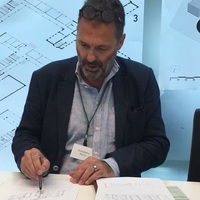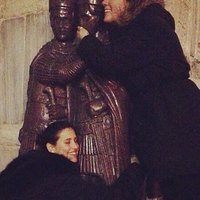
antonia clarkeson
Biography / Profile
“I have observed, that a Reader seldom peruses a Book with Pleasure ‘till he knows whether the Writer of it be a black or a fair Man, of a mild or cholerick Disposition, Married or a Batchelor, with other Particulars of the like nature, that conduce very much to the right Understanding of an Author. To gratify this Curiosity, which is so natural to a Reader, I design this Paper …”
When Richard Steele and Joseph Addison started their famous daily newspaper The Spectator in 1711, the first edition, published on Thursday, March 1, 1711, opened in such fashion, with a sort of ‘Who am I?’
I am unable, dear Reader, “To gratify this Curiosity, which is so natural to a Reader”.
Suffice to say that I am an independent researcher, motivated by a common and continuing refrain within architectural commentary: Blame the artisan for the bits that don’t fit! I write in awe of the poetic prowess of the artisan.
“I have observed, that a Reader seldom peruses a Book with Pleasure ‘till he knows whether the Writer of it be a black or a fair Man, of a mild or cholerick Disposition, Married or a Batchelor, with other Particulars of the like nature, that conduce very much to the right Understanding of an Author. To gratify this Curiosity, which is so natural to a Reader, I design this Paper …”
When Richard Steele and Joseph Addison started their famous daily newspaper The Spectator in 1711, the first edition, published on Thursday, March 1, 1711, opened in such fashion, with a sort of ‘Who am I?’
I am unable, dear Reader, “To gratify this Curiosity, which is so natural to a Reader”.
Suffice to say that I am an independent researcher, motivated by a common and continuing refrain within architectural commentary: Blame the artisan for the bits that don’t fit! I write in awe of the poetic prowess of the artisan.
less
Related Authors
Virginia De Jorge Huertas
Universidad Rey Juan Carlos
Daniel Sherer
Princeton University
Alessandro Rocca
Politecnico di Milano
Renata Jadresin Milic
Unitec New Zealand
Alexandria Rebecca
Stanford University
Vane Nedev
St Cyril and Methodius, Skopje, Macedonia
Mark Rakatansky
Columbia University
Pablo Lorenzo-Eiroa
New York Institute of Technology







Uploads
Miscellaneous by antonia clarkeson
for upcoming publication
READING (uncensored) PALLADIO IN LIGHT OF AUSTRALIAN VERNACULAR ARCHITECTURE. Announcing the Forthcoming Publication: by Cambridge Scholars Publishing, Newcastle Upon Tyne NE6 2PA UK.
forthcoming, Dec. 2024
not, escape the censor’s notice;
and did not escape the censor’s cut.
Palladio’s I quattro libri dell’architettura—that is, Palladio’s original uncensored work—is represented here as
pursuing a cause:
the case for architecture as vernacular;
the antithesis of colonial mentality that refers and defers to some principle other than here;
framing a more specific cause:
establishing an Italic identity for polyglot city states, by affirming and illustrating its roots in traditional praxis that has
consistent and articulate philosophical historicity and mathematical sophistication.
The architectural practice of Francis Howard Greenway and Mary Moore Greenway in Australia, begotten of a long
line of architects and freestone masons and builders in Bristol U.K., demonstrates that the Greenways knew and studied
and applied the un-censored version of Palladio’s famous four books of architecture.
Francis Howard Greenway and Mary Moore Greenway were well aware that their architectural practice in Australia
was in service to a colonial aggressor, as intent upon conquest and pillage and rape and dispossession—and expiation—
as any classical Greek colonial enterprise or republican Venetian counterpart.
But they knew, encouraged by Macquarie, the colonial governor, that they could determine the form that expiation
might take.
That would come from their focus on fundamentals.
Study of actual built works that comprise the Greenway portfolio of architectural design in Australia (Herman 1970,
Broadbent & Hughes 1999) prompts some observations which may serve to clarify
(i) a system of proportionality evident in Palladio’s published and built works;
(ii) length of Vicentine foot;
(iii) apparent discrepancies between designs-published and designs-executed;
(iv) continuity with predecessors in treatment of Order;
(v) Palladio’s contribution to debate about adoption of a metric measure.
The opening discussion serves as introduction to each of the listed issues, which have cumulative effect.
Karia and the Ausralian context by antonia clarkeson
The customary repudiation of the accounts offered by Herodotus and Pliny arises from the interpretations given to those words. So, in the following discussion, I invite you to consider the word triakonta and the structure of the phrases in Herodotus; and the words cubitus, pedum, and the phrase sexagenos ternos pedes in Pliny.
Greenway by antonia clarkeson
In this Essay, I focus on Light House Plan: “By S.L. Harris C. Architect”.
Goulburn’s BRADLEY GRANGE, designed c.1832, apparently was the last opportunity to do so.
Both complexes
• are officially recognised by the NSW Office of Heritage as Greenway designs;
• are designed on the same principles; share and exhibit the same standards of measurement;
• present the same dimensions and distances, though differently configured;
• incorporate similar historical references;
• exhibit the same commitment to the architecture of ‘place’ as dimensionally unique;
• celebrate the distinctive character of their clientele;
• present the same proportionality between English and metric measures.
Instead of commentary upon matters of ‘style’ these Notes concentrate on other features of the designs, exhibited especially in their dimensional measurements.
Newton as Architect by antonia clarkeson
One word that receives little attention in the commentary about Newton’s major published work is the word Principia. In fact, the word is rarely even translated.
Each word chosen by Newton for his title has basic meaning, as well as developing context of usage. Attention to basic meaning, however, can be illuminating, can be apollonian, in the sense that it washes off accumulations that might obscure the radiance of the word itself.
In this Essay, consider the meaning of the words that Newton actually uses to express himself. In the process, we might discover some unappreciated relevance of Newton’s original thinking for current problems in contemporary theory of how the world is made.
The singular word is principium, which means “beginning, start, origin”.
Principia thereby are beginnings, things to start with, origins.
The Latin principium is the greek arche.
Our objective is to explore the philosophical foundations of the claim that Isaac Newton was fundamentally an architectural theorist.
for upcoming publication
READING (uncensored) PALLADIO IN LIGHT OF AUSTRALIAN VERNACULAR ARCHITECTURE. Announcing the Forthcoming Publication: by Cambridge Scholars Publishing, Newcastle Upon Tyne NE6 2PA UK.
forthcoming, Dec. 2024
not, escape the censor’s notice;
and did not escape the censor’s cut.
Palladio’s I quattro libri dell’architettura—that is, Palladio’s original uncensored work—is represented here as
pursuing a cause:
the case for architecture as vernacular;
the antithesis of colonial mentality that refers and defers to some principle other than here;
framing a more specific cause:
establishing an Italic identity for polyglot city states, by affirming and illustrating its roots in traditional praxis that has
consistent and articulate philosophical historicity and mathematical sophistication.
The architectural practice of Francis Howard Greenway and Mary Moore Greenway in Australia, begotten of a long
line of architects and freestone masons and builders in Bristol U.K., demonstrates that the Greenways knew and studied
and applied the un-censored version of Palladio’s famous four books of architecture.
Francis Howard Greenway and Mary Moore Greenway were well aware that their architectural practice in Australia
was in service to a colonial aggressor, as intent upon conquest and pillage and rape and dispossession—and expiation—
as any classical Greek colonial enterprise or republican Venetian counterpart.
But they knew, encouraged by Macquarie, the colonial governor, that they could determine the form that expiation
might take.
That would come from their focus on fundamentals.
Study of actual built works that comprise the Greenway portfolio of architectural design in Australia (Herman 1970,
Broadbent & Hughes 1999) prompts some observations which may serve to clarify
(i) a system of proportionality evident in Palladio’s published and built works;
(ii) length of Vicentine foot;
(iii) apparent discrepancies between designs-published and designs-executed;
(iv) continuity with predecessors in treatment of Order;
(v) Palladio’s contribution to debate about adoption of a metric measure.
The opening discussion serves as introduction to each of the listed issues, which have cumulative effect.
The customary repudiation of the accounts offered by Herodotus and Pliny arises from the interpretations given to those words. So, in the following discussion, I invite you to consider the word triakonta and the structure of the phrases in Herodotus; and the words cubitus, pedum, and the phrase sexagenos ternos pedes in Pliny.
In this Essay, I focus on Light House Plan: “By S.L. Harris C. Architect”.
Goulburn’s BRADLEY GRANGE, designed c.1832, apparently was the last opportunity to do so.
Both complexes
• are officially recognised by the NSW Office of Heritage as Greenway designs;
• are designed on the same principles; share and exhibit the same standards of measurement;
• present the same dimensions and distances, though differently configured;
• incorporate similar historical references;
• exhibit the same commitment to the architecture of ‘place’ as dimensionally unique;
• celebrate the distinctive character of their clientele;
• present the same proportionality between English and metric measures.
Instead of commentary upon matters of ‘style’ these Notes concentrate on other features of the designs, exhibited especially in their dimensional measurements.
One word that receives little attention in the commentary about Newton’s major published work is the word Principia. In fact, the word is rarely even translated.
Each word chosen by Newton for his title has basic meaning, as well as developing context of usage. Attention to basic meaning, however, can be illuminating, can be apollonian, in the sense that it washes off accumulations that might obscure the radiance of the word itself.
In this Essay, consider the meaning of the words that Newton actually uses to express himself. In the process, we might discover some unappreciated relevance of Newton’s original thinking for current problems in contemporary theory of how the world is made.
The singular word is principium, which means “beginning, start, origin”.
Principia thereby are beginnings, things to start with, origins.
The Latin principium is the greek arche.
Our objective is to explore the philosophical foundations of the claim that Isaac Newton was fundamentally an architectural theorist.
well if one understands music. The issue of harmony is common to both; and the
harmonious conjunction of measures is Newton’s quest in his Dissertation.
Harmonious conjunction of measures (or concinnitas as Alberti called it) is also
Francis Howard Greenway’s quest. In the design of his buildings he frequently
makes explicit (and pertinent) references to musical measures in his work, as will be
seen in discussion of the Case Studies discussed elsewhere.
It might be appropriate therefore to note a few things about the musical analogy.
It is the physicality of music that interests both Newton and Greenway.
The Ionic foot has Etruscan provenance. In its metric measure format, it represents as 0.267857142m. It finds expression in the relationship between vibrant metre in its bulk Magnitude and the two diameters of Ionic columns, identified in the structural arrangement of the Maussolleion:
4 x 0.267857142m x (1.17333...m x 0.79545...m) = 1.00m3.
In the face of the evident lack of professional consensus about the actual extension of the Ionic foot, I conclude that there are two related measures that can legitimately claim to be of Ionic type.